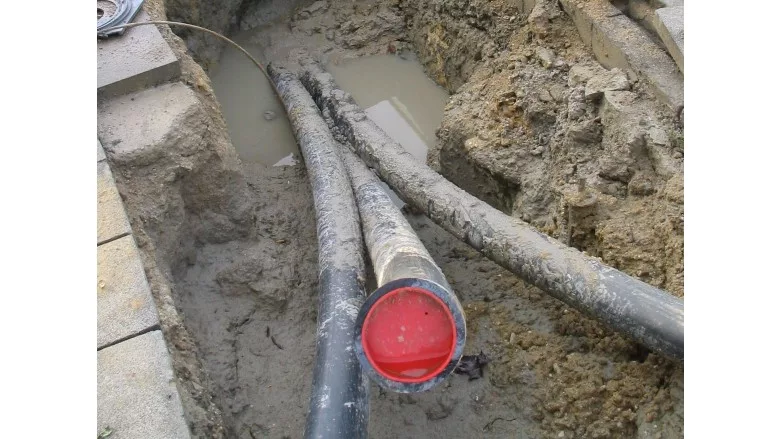A Total Company Understanding of HDD Fluids
Tricky Geologies, Sticky Clays Often Call for More

The goal is installed product, right? Well, columnist Todd Tannehill says sometimes it pays to use more than just a one-bag drilling fluids solution.
Source: FRAC / Creative Commons / CC-BY-SA-2.5
We get called to many jobsites to consult with drillers for many different reasons. On horizontal directional drilling (HDD) sites, that usually means recommending a drilling fluid mix or even a fluids recipe catered to a specific job. It would be great if all one-bag mixes worked in every soil condition, but they do not. The design of one-bag mixes covers the “middle of the road” conditions, your average material. However, when conditions swing between sticky clay, sand and gravel, or cobble, the mix needs a little boost. In complex geologies like these, we usually recommend supplemental polymers and additives to assist in the successful completion of the bore.
Many times after these recommendations, I hear, “They aren’t going to let me buy those,” or “We don’t have enough money in the job to support additional products!” I argue that these types of products typically reduce overall costs. As fluids consultants, we make it our goal to help contractors maximize drilling efficiency by using the proper blend of products. I always remind cost-conscious project managers that these types of products will increase penetration rates, better keep the hole open and help them complete jobs without costly delays.
Remember, a successful drilling fluid:
- Cools and lubricates the bit
- Suspends and transports the cuttings out of the borehole
- Holds the borehole open
- Controls fluid loss, loss of circulation and frackouts
- Reduces torque
- And controls subsurface pressure
Those six bullet points, if accomplished, equal a successful bore and properly installed product. We typically get called to a site if the above objectives are not met. While we can provide drilling fluid recommendations to increase drilling efficiency, we don’t control the purse strings. The old saying, “You can lead a horse to water, but you can’t make it drink,” fits perfectly here. Our number one concern when designing a drilling fluid mix is getting the job done. We aren’t the banker and we don’t make any decisions onsite. We make recommendations that the contractor can use (or not) to complete the job. It’s that simple.
For this reason, when teaching a drilling fluid class, I like to have a 360-degree representation of the company in attendance. Many times, we get the drillers, locators, supervisor and laborers. While that group represents the field team, other team members that can also find value in attending a mud school. For example:
- The company owner/general manager: Getting proper yields out of products is always an interest to the person or people controlling costs and profits. They can also get an understanding that the savings gained from using a one-bag product without additives (when geology calls for otherwise), often fail to cover the potential for extra time on the job and increased wear on company assets.
- The estimator: When bidding jobs, the person bidding needs to know what extra polymers and additives might be required for expected soil conditions. It’s better to have the extra money available than not.
- The job superintendent: Knowing what to expect can take the unknowns out of the job that they are responsible for.
I recently had the pleasure of teaching a class to a company with a very proactive owner. He brought in all of his field crews, the estimator and office personnel to attend the class. During the class, we learned that one crew was replacing tooling at a higher rate than others. We quickly identified the differences between the crews : All except for one had training in the proper use of drilling fluid. The offending crew used only water. In this instance, the owner could quickly calculate that the added cost of wear on tooling, rods and overheated sondes dwarfed the cost of consistently using the proper drilling fluids. In fairness, this was the driller’s first mud class and he learned quickly.
In this instance, the owner could quickly calculate that the added cost of wear on tooling, rods and overheated sondes dwarfed the cost of consistently using the proper drilling fluids.
The part of this story I want to highlight is that the owner, who started as a driller, knew the value of a proper drilling fluid. He knew to look at the stats and see the tooling cost differences between his multiple crews. He could analyze production rates and calculate the cost of not using a proper drilling fluid. The class offered a great refresher for the other crews but, more important, the crew using only water learned to see and understand the differences. The owner invested the time (out of the field) in training and the results will pay back every day going forward.
Just like the rig, mixing system, trucks and trailers, a proper drilling fluid, tooling and plan is an investment in success. The fluids sometimes get overlooked, but not by those in the know — and everyone needs to know.
Looking for a reprint of this article?
From high-res PDFs to custom plaques, order your copy today!


